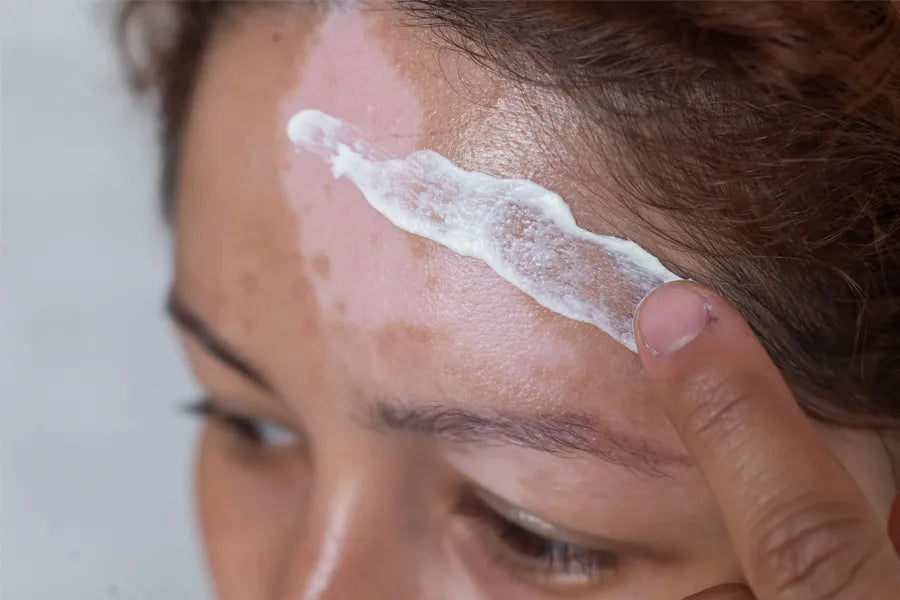Life leaves its mark and scars are often the most powerful stories etched onto your skin. But sometimes, they can make you feel a little self-conscious.
When they do, you can seek the help of makeup. Start with a primer, then layer on a high-coverage camouflage cream. Set it with a powder to lock everything in place.
So, come, let's conceal those scar concerns and celebrate your beautiful skin!
Understanding Scars
Scars are the visible reminders left on the skin after the body repairs itself following an injury that reaches the dermis, the thick inner layer.
As your skin fixes itself, it creates a patch of tissue made of collagen to close the wound. That patch is the scar.
Cuts, burns, acne breakouts, diseases like chickenpox and surgical procedures can all scar your skin.
The healing process can lead to some wounds with a barely noticeable scar, while others form a raised texture.
The variations in the scar are caused by several factors, including the degree of skin damage, how well your body responds, where the wound is present and even your age.
Steps To Mask Your Scars With Camouflage Cream
- Prepping Your Skin
Treating your skin to a prepping routine before applying a camouflage cream is absolutely essential. It helps in creating a flawless base for smooth application.
Clean
Begin by washing your skin to remove any dirt, sweat or oil that might have been accumulated. A gentle, non-comedogenic cleanser is your best bet.
It will cleanse your skin without stripping away its natural oils. Work the cleanser into your skin with slow, circular motions. Finally, rinse your skin clean with lukewarm water.
Moisturise
A good moisturiser hydrates and nourishes your skin, keeping it feeling soft and supple. So, choose a moisturiser formulated for your specific skin type for hydration.
After washing your face, pat it dry as it retains a touch of dampness, then immediately apply moisturiser to seal in the hydration. Apply it with a light, circular motion using your fingertips.
Sun Protection
Your skincare routine is not complete without sunscreen as it is your daily defence against sun damage.
And, scars in the early stages of healing are highly susceptible to sunburn because the skin is actively rebuilding itself.
Sun might exacerbate your existing scars, making them thicker. This vulnerability renders sun protection even more crucial to prevent any further damage.
So, apply a generous amount of sunscreen after moisturising. Pick a sunscreen with SPF 30 or higher and ‘broad spectrum’ labelling to ensure it guards you against both UVA and UVB rays.
Primer
Scars can bring about a bumpy and uneven texture on your skin. And, primer not only smoothens the texture but also lets your makeup last longer.
The smooth, unified surface achieved by the primer also allows the camouflage cream to adhere better. Focus on the scarred areas and gently dab a thin layer of primer with your fingertips.
This serves as a base coat for the camouflage cream to bring an even coverage over the uneven scar.
- Applying Camouflage Cream
When it comes to concealing a scar, the application of camouflage cream stands at the heart of the process. Regular makeup can offer a light touch-up, but camouflage cream goes the extra mile.
Its high coverage and pigmentation are designed to efficiently hide scars. The cream can blend with your skin for a natural-looking finish.
Now, select a camouflage cream that matches your skin tone. You might need to mix two shades to get the right colour that suits your skin.
Dewy or glowy camouflage creams might seem appealing, but they are not the correct choice for your scars. The glow can highlight the uneven texture. So, stick to matte formulas for superior scar coverage.
Use a clean brush or makeup sponge to spread the camouflage cream over the scar. Apply a light layer initially and build for the desired concealment.
For the best results, simply pat the cream onto the scar. Do not rub it in.
- Sealing The Makeup
Setting makeup with a translucent powder acts like a final layer, stopping it from smudging throughout the day. Your scar coverage can enjoy extended wear, free from fading or creasing.
Dip a fluffy brush lightly into the translucent powder. Tap off any excess for a lightweight finish.
Gently press the powder into the skin with the brush, rather than sweeping it back and forth. This will result in a softer, more natural camouflage effect.
Tailoring Techniques To Specific Scar Types
Different types of scars require slightly varied makeup approaches to conceal their appearance. Here’s how you can deal with some of the common scar types:
- Acne Scars
You can hide your acne scar pits by using a primer that provides an even base. Apply a thin layer first, then follow up with the camouflage cream.
For red or pink acne scars, a green colour corrector is used to neutralise the redness, making the scar less visible. Brown or dark scars can be tackled with an orange or peach colour corrector.
- Burn Scars
Depending on your burn scar's hue, a colour corrector can be used to reduce its impact. Grab a light green colour corrector to address the red burn scars.
The yellowish burn scars can benefit from a red or orange colour corrector. Mask the scar with the full-coverage camouflage cream that becomes one with your natural complexion.
- Stretch Marks
Stretch marks might respond positively to increased skin hydration. Give your skin a healthy barrier with a moisturiser packed with cocoa butter or shea butter. Use a colour corrector, if necessary.
Spread the camouflage cream in long strokes and cover the lines. Buffing the cream with a sponge can camouflage the stretch marks well.
Darclore: Own Your Scar
Darclore is here with the camouflage creams to make you feel your most confident self. Our innovative formula, with the highest concentration of pigments, easily camouflages any scars, anywhere on your body.
Our products are dermatologist-tested and gentle for all skin types. So, find your perfect shade from our diverse range of 12 and be the bold, beautiful you!

